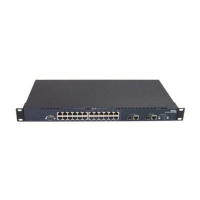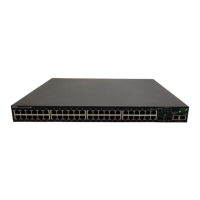BigIron RX Series Configuration Guide 687
53-1002253-01
Configuring OSPF
25
You set global level parameters at the OSPF CONFIG Level of the CLI. To reach that level, enter router
ospf… at the global CONFIG Level. Interface parameters for OSPF are set at the interface CONFIG
Level using the CLI command, ip ospf…
Enable OSPF on the router
When you enable OSPF on the router, the protocol is automatically activated. To enable OSPF on
the router, use the following method.
BigIron RX(config)# router ospf
This command launches you into the OSPF router level where you can assign areas and modify
OSPF global parameters.
Note regarding disabling OSPF
If you disable OSPF, the device removes all the configuration information for the disabled protocol
from the running configuration. Moreover, when you save the configuration to the startup
configuration file after disabling one of these protocols, all the configuration information for the
disabled protocol is removed from the startup configuration file.
The CLI displays a warning message such as the following.
BigIron RX(config-ospf-router)# no router ospf
router ospf mode now disabled. All ospf config data will be lost when writing to
flash!
If you have disabled the protocol but have not yet saved the configuration to the startup
configuration file and reloaded the software, you can restore the configuration information by
re-entering the router ospf command to enable the protocol. If you have already saved the
configuration to the startup configuration file and reloaded the software, the information is gone.
If you are testing an OSPF configuration and are likely to disable and re-enable the protocol, you
might want to make a backup copy of the startup configuration file containing the protocol’s
configuration information. This way, if you remove the configuration information by saving the
configuration after disabling the protocol, you can restore the configuration by copying the backup
copy of the startup configuration file onto the flash memory.
Assign OSPF areas
Once OSPF is enabled on the system, you can assign areas. Assign an IP address or number as the
area ID for each area. The area ID is representative of all IP addresses (subnets) on a router port.
Each port on a router can support one area.
An area can be normal, a stub, or a Not-So-Stubby Area (NSSA).
• Normal – OSPF routers within a normal area can send and receive External Link State
Advertisements (LSAs).
• Stub – OSPF routers within a stub area cannot send or receive External LSAs. In addition, OSPF
routers in a stub area must use a default route to the area’s Area Border Router (ABR) or
Autonomous System Boundary Router (ASBR) to send traffic out of the area.
• NSSA – The ASBR of an NSSA can import external route information into the area.

